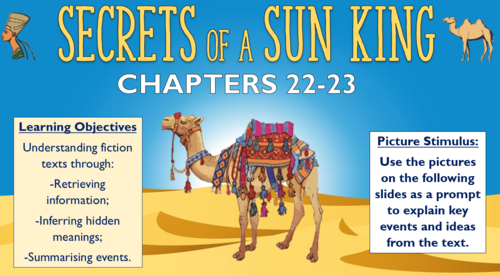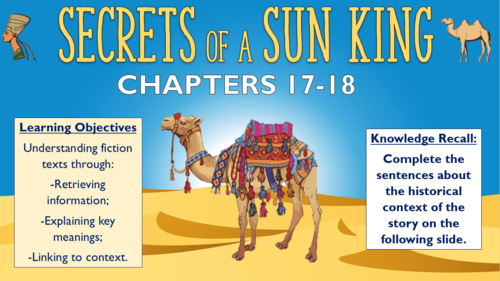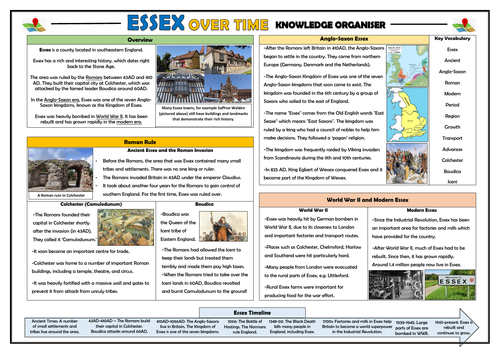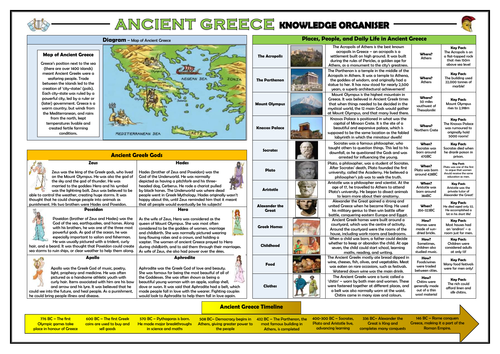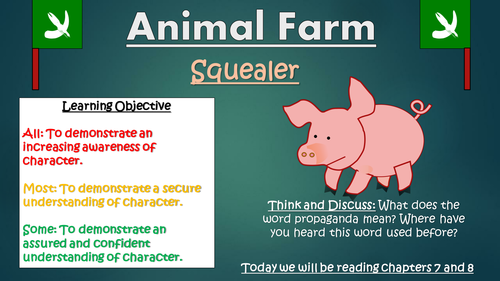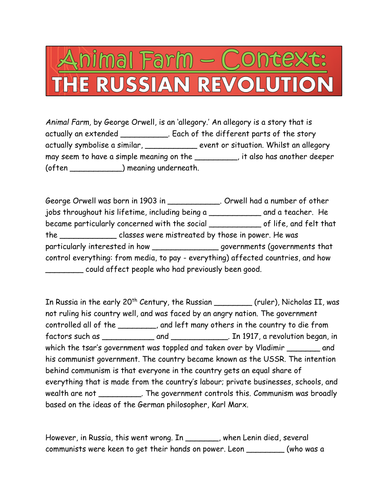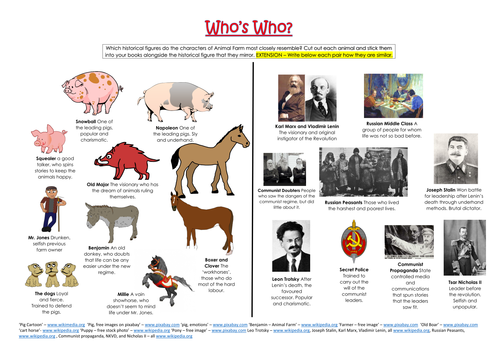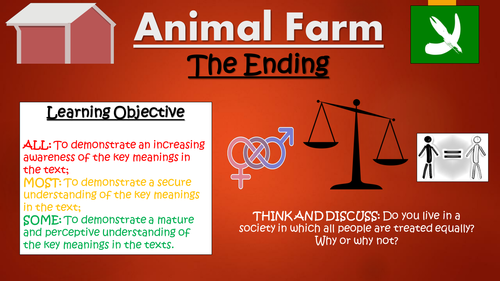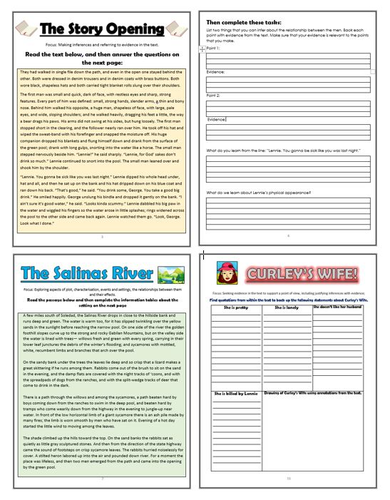
3k+Uploads
1972k+Views
2284k+Downloads
History

Secrets of a Sun King - Chapters 22 and 23 - Double Lesson!
This engaging and thought-provoking double-lesson resource aids students in developing a secure understanding of the chapters 22 and 23 of Emma Carroll’s 'Secrets of a Sun King.’ In this final section of the text, the group returns to London triumphant, and Alex’s true identity is finally revealed.
The comprehensive and colourful PowerPoint presentation enables students to understand the text through:
-Retrieving information;
-Inferring hidden meanings;
-Summarising key events.
The sessions include a range of retrieval, vocabulary, inference, explanation and deeper thinking activities. A clear, colourful and comprehensive PowerPoint presentation guides students through the learning. A storyboard template is also provided for the creative activity.
There’s a lot in the session (18 slides in total) so I would recommend breaking into two lessons. The lessons are most suitable for children in key stage 2, (they were originally used for those in years 4 and 5).

Secrets of a Sun King - Chapters 17 and 18 - Double Lesson!
This engaging and thought-provoking double-lesson resource aids students in developing a secure understanding of the chapters 17 and 18 of Emma Carroll’s 'Secrets of a Sun King.’ In this section of the text, the children are helped towards the burial site by Pepe and his camels.
The comprehensive and colourful PowerPoint presentation enables students to understand the text through:
-Retrieving information;
-Explaining key meanings;
-Linking the events in the text to context.
The sessions include a range of retrieval, vocabulary, inference, explanation and deeper thinking activities. A clear, colourful and comprehensive PowerPoint presentation guides students through the learning.
There’s a lot in the session (18 slides in total) so I would recommend breaking into two lessons. The lessons are most suitable for children in key stage 2, (they were originally used for those in years 4 and 5).

Essex Over Time - History Knowledge Organiser!
This clear, detailed and visually-appealing resource offers a complete reference point for children learning about Essex over time as a part of their history study of ‘significant historical places in their own locality.’ It tracks the main events and developments within the county at significant moments in time, and contains comprehensive sections entitled:
Overview;
Roman Rule (inc. Roman invasion, Colchester, and Boudica);
Anglo-Saxon Essex;
World War II and Modern Essex;
Important Vocabulary;
Essex Timeline.
This was originally taught to children in years 2 and 3, but can be easily adapted for slightly older/ younger year groups if needed. The resource is designed to be printed onto A3, and is provided as both a PDF and a Word version (so that you can edit if you want to). All images used are licensed for commercial use.

Significant Explorers - Neil Armstrong Lesson!
In this engaging and purposeful lesson, children develop an understanding of the Apollo 11 mission and Neil Armstrong, as a part of their study of significant explorers.
In particular, they:
-Learn who Armstrong was and what he is best-known for;
-Understand how his achievements impacted the world;
-Use their researching skills to find out more about Armstrong and his mission.
The learning is guided by a clear and colourful PowerPoint presentation, which guides students through the following step-by-step journey:
-Knowledge recall of basic history skills, key terms, and the meaning of exploration;
-Gaining a background understanding of the Space Race and the drive to put humans on the Moon;
-Learning about the risks and difficulties involved with the mission;
-Watching an engaging, age-appropriate video to learn key details about the mission;
-Using a research template to find out more information about the mission;
-Empathising with Armstrong, through a hot-seating activity;
-Self-reflecting on the extent to which they believe they have met the learning objective.
Included is the comprehensive PowerPoint presentation (20 slides), which contains all of the information needed to teach the lesson. Also included is the template for the research activity.
In the past, I have used this lesson with children in lower KS2 (years 3 and 4) but they could easily be used with upper KS2 - the key learning is aligned with curriculum expectations for history. All images are licensed for commercial use.

Significant Explorers - Comparing Explorers Lesson!
In this engaging and purposeful lesson, children develop their understanding of different explorers from over time. In this lesson, children sequence exploration events and compare explorers from over time.
Specifically, they:
-Recall the achievements of different explorers from across history;
-Place significant exploration events in chronological order;
-Consider how the role of explorers has changed over time.
It was originally taught as the final lesson in a sequence of lessons focusing on different explorers. Please note that to complete the final written task, it does help if children have either been taught the prior lessons in this sequence (available on this platform) or have other prior understanding of at least two explorers.
The learning is guided by a clear and colourful PowerPoint presentation, which guides students through the following step-by-step journey:
-Knowledge recall of basic history skills, key terms, the meaning of exploration, and the achievements of different explorers;
-Following clear instructions and utilising given resources to produce their own timelines of different exploration achievements from between 1400 to the present day.
-Using information and prompts to compare and contrast different explorers from across time;
-Self-reflecting on the extent to which they believe they have met the learning objective.
Included is the comprehensive PowerPoint presentation (20 slides), which contains all of the information needed to teach the lesson. Also included are the event cards for the timeline activity.
In the past, I have used this lesson with children in lower KS2 (years 3 and 4) but they could easily be used with upper KS2 - the key learning is aligned with curriculum expectations for history. All images are licensed for commercial use.

Significant Explorers - Amelia Earhart Lesson!
In this engaging and purposeful lesson, children develop an understanding of the well-known aviator Amelia Earhart, as a part of their study of significant explorers.
In particular, they:
-Learn who Earhart was and what she is best-known for;
-Understand the context of the world in which she lived;
-Explain what made her achievements so inspirational;
-Evaluate how she demonstrated the characteristics of a successful explorer.
The learning is guided by a clear and colourful PowerPoint presentation, which guides students through the following step-by-step journey:
-Knowledge recall of basic history skills, key terms, and the meaning of exploration;
-Gaining a background understanding of the world in which Amelia Earhart lived, including technological developments and gender expectations;
-Learning about her life and her key achievements, and discussing which they feel are most impressive and why;
-Discussing how Earhart was an inspiration, through discussing her achievements, legacy and key quotations;
-Evaluating how Earhart demonstrated the key characteristics of successful explorers, through a ‘Diamond 9’ activity.
-Self-reflecting on the extent to which they believe they have met the learning objective.
Included is the comprehensive PowerPoint presentation (21 slides), which contains all of the information needed to teach the lesson. Also included are the templates for the Diamond 9 activity.
In the past, I have used this lesson with children in lower KS2 (years 3 and 4) but they could easily be used with upper KS2 - the key learning is aligned with curriculum expectations for history. All images are licensed for commercial use.

Significant Explorers - Edmund Hillary and Tenzing Norgay Lesson!
In this engaging and purposeful lesson, children develop an understanding of Edmund Hillary and Tenzing Norgay, the first climbers to reach the summit of Mount Everest.
In particular, they:
-Learn who Hillary and Norgay were and what they are known for;
-Explain what made their achievements so incredible;
-Learn more about the personality traits of both Hillary and Norgay;
-Evaluate how both climbers were recognised after the climb.
The learning is guided by a clear and colourful PowerPoint presentation, which guides students through the following step-by-step journey:
-Knowledge recall of basic history skills, key terms, and the meaning of exploration;
-Gaining a background understanding of the dangers of climbing extremely high mountains;
-Watching an engaging video (hyperlinked) to gain a base understanding of the key details of the climb;
-Considering the key details and personality traits of both climbers;
-Evaluating how the recognition for Hillary and Norgay differed after the successful climb, reflecting on how fair they feel this was;
-Self-reflecting on the extent to which they believe they have met the learning objective.
Included is the comprehensive PowerPoint presentation (19 slides), which contains all of the information needed to teach the lesson. Also included are the images for the character profile activity.
In the past, I have used this lesson with children in lower KS2 (years 3 and 4) - the key learning is aligned with curriculum expectations for history. All images are licensed for commercial use.

Dorothy Hodgkin Knowledge Organiser!
This clear, detailed and visually-appealing resource offers a complete reference point for children learning about Dorothy Hodgkin, either as a part of their history study of ‘Significant Individuals’, or research into famous scientists and inventors. It contains comprehensive sections entitled:
Overview;
Times in Her Life;
Important Vocabulary;
Dorothy Hodgkin Timeline;
Answers to the Important Questions;
Top Ten Facts.
The resource is designed to be printed onto either A4 or A3, and is provided as both a PDF and a Word version (so that you can edit if you want to). All images used are licensed for commercial use.

Ancient Greece Knowledge Organiser!
This clear, detailed and visually-appealing resource offers a complete reference point for students learning or revising knowledge relating to the Ancient Egyptians. It contains comprehensive sections on:
Ancient Greece map (annotated);
Ancient Greek Gods;
Ancient Greece timeline;
Ancient Greek people;
Ancient Greek places;
Ancient Greek daily life.
The resource is designed to be printed onto A3, and is provided as both a PDF and a Word version (so that you can edit if you want to). All images used are licensed for commercial use and are cited on a separate document (included). It is most suitable for children in KS2 and KS3.

John Logie Baird - Knowledge Organiser!
This clear, detailed and visually-appealing resource offers a complete reference point for children learning about John Logie Baird, either as a part of their history study of ‘Significant Individuals’, or research into famous scientists and inventors. It contains comprehensive sections entitled:
Overview;
Times in His Life;
Important Vocabulary;
John Logie Baird Timeline;
Answers to the Important Questions;
Top Ten Facts.
The resource is designed to be printed onto either A4 or A3, and is provided as both a PDF and a Word version (so that you can edit if you want to). All images used are licensed for commercial use.

Animal Farm: Squealer (Double Lesson!)
These resources enable students to understand and analyse the character of Squealer in George Orwell’s Animal Farm. More precisely, students learn to make clear and accurate interpretations regarding his role in within the consolidation of Napoleon’s dictatorship. Students also demonstrate their understanding of chapters 7 and 8, with a particular emphasis upon the actions of Squealer. There are easily enough resources here for two lessons.
Students learn through the following tasks:
- Gauging and collaborating previous knowledge of 'propaganda' through a discussion-based starter task;
- Using an interactive, out-of-seat, group activity to build understanding of the features of propaganda;
- Reading chapters 7 and 8 with a particular focus on the character of Squealer, and demonstrating their understanding through a related activity sheet;
- Developing their understanding of Squealer's actions, and finding textual evidence to back this up, through a scaffolded, retrieval activity;
- Using their imaginative and creative skills, in addition to their knowledge of Squealer and propaganda posters, to construct their own propaganda poster for Animal Farm;
- Peer assessing their partners' learning attempts.
The following resources are provided:
- Engaging and colourful step-by-step PowerPoint
- Teacher lesson guidance/plan;
- Squealer's Propaganda worksheet;
- Four propaganda texts for group analysis;
- Template for recording group analysis;
- Chapters 7 and 8 worksheet (plus teacher answer sheet);
- Copies of Chapters 7 and 8.
All images and videos are licensed for commercial use, and are cited on the final slide of the PowerPoint.

Animal Farm: Context - The Russian Revolution
These resources enable students to understand the context of the Russian Revolution, the predominant subject of Orwell’s allegory within Animal Farm. More precisely, students learn about the key historical events and figures throughout this point in time in Russian history, and begin to comprehend Orwell’s intentions in writing the novella. These resources give students a strong foundation of knowledge which they can then utilise to begin confidently relating the text to its context. There are easily enough resources for at least two lessons within this resource pack.
Students learn through the following tasks:
- Gauging and collaborating previous knowledge through a discussion-based starter task;
- Watching, listening, and demonstrating their understanding of an engaging and informative context video and related activity sheet;
- Developing their understanding through in-depth investigative research into the main leaders of the Russian Revolution;
- Writing a letter from the viewpoint of a member of the Russian working class, who has lived through the various regimes and revolutions.
- Peer assessing their partners’ learning attempts.
The following resources are provided:
- Engaging and colourful step-by-step PowerPoint (includes links for video)
- Teacher lesson guidance/plan;
- Context worksheet;
- Five investigative research templates: Stalin, Lenin, Trotsky, Marx, and The Secret Police.
All images and videos are licensed for commercial use, and are cited on the final slide of the PowerPoint. Note - internet connection is needed for the video activity.

Clement Attlee - Knowledge Organiser!
This clear, detailed and visually-appealing resource offers a complete reference point for children learning about Clement Attlee as a part of their history study of ‘Significant Individuals.’ It contains comprehensive sections entitled:
Overview;
Times in His Life;
Important Vocabulary;
Clement Attlee Timeline;
Answers to the Important Questions;
Top Ten Facts.
The resource is designed to be printed onto either A4 or A3, and is provided as both a PDF and a Word version (so that you can edit if you want to). All images used are licensed for commercial use.

The Romans Knowledge Organiser!
This clear, detailed and visually-appealing resource offers a complete reference point for students learning or revising knowledge relating to the Romans. It contains comprehensive sections on:
Roman Empire map (annotated);
Roman Leaders and Emperors;
Roman timeline;
Roman places and landmarks;
Roman daily life.
The resource is designed to be printed onto A3, and is provided as both a PDF and a Word version (so that you can edit if you want to). All images used are licensed for commercial use and are cited on a separate document (included). It is most suitable for children in KS2 and KS3.

Animal Farm: Old Major's Dream and The Revolution!
These resources enable students to understand and analyse the Old Major’s dream and the events of the animal revolution, in the opening two chapters of George Orwell’s Animal Farm. More precisely, students learn to make clear and accurate interpretations about events and characters, with appropriate links to the Orwell’s allegory and relationship to context.
Students learn through the following tasks:
- Gauging and collaborating previous knowledge through a discussion-based starter task;
- Reading the first two chapters and demonstrating their understanding through a related activity sheet;
- Developing their understanding of characters and context through a a making links activity;
- Analysing the allegorical nature of the opening chapters by further exploring the connections between characters and contexts;
- Peer assessing their partners' learning attempts.
The following resources are provided:
- Engaging and colourful step-by-step PowerPoint (includes links for video)
- Teacher lesson guidance/plan;
- Chapters 1 and 2 worksheet;
- Making Links Activity Sheet (1x more difficult, 1 x easier);
- Copies of Chapters 1 and 2.
All images and videos are licensed for commercial use, and are cited on the final slide of the PowerPoint. Note - internet connection is needed if you plan to use the video.

The Charge of the Light Brigade Knowledge Organiser/ Revision Mat!
This detailed and visually-appealing resource offers a complete reference point for students learning or revising Alfred, Lord Tennyson’s power and conflict poem 'The Charge of the Light Brigade.’ It contains comprehensive sections on:
Context;
Line-by-line Analysis;
Poetic Devices/ Language Devices;
Themes;
Form/Structure;
Poems for Comparison;
The Poet’s Influences.
Key words and ideas are underlined for easy reference. The resource is designed to be printed onto A3, and is provided as both a PDF and a Word version (so that you can edit if you want to). All images used are licensed for commercial use and are cited on a separate document (included).

Animal Farm: Dictatorship
These resources enable students to understand and analyse the characteristics of Napoleon’s dictatorship in George Orwell’s Animal Farm. In addition, students learn to make clear and accurate interpretations regarding the events of the chapters 5 and 6, (as Napoleon’s dictatorship begins to emerge) and make appropriate links to individual characters and their allegorical relationship to context. As these chapters signal the end of the animal democracy on the farm, and the start of Napoleon's totalitarian dictatorship, a heavy emphasis throughout these resources is placed upon the character of Napoleon - particularly with regards to his similarities with Joseph Stalin.
There are easily enough resources for two lessons within this pack. Students learn through the following tasks:
- Gauging and collaborating prior knowledge through a discussion-based starter task;
- Gauging their knowledge of key terms such as 'totalitarian' and 'oppression' through a collaborative card-sorting activity;
- Reading chapters 5 and 6 and demonstrating their understanding through an apt and informative worksheet;
- Developing their understanding of the main character of Snowball, and his allegorical equivalent, Joseph Stalin, through a comparison task;
- Analysing the links between Napoleon and Stalin in chapters 5 and 6, using a templated writing frame;
- Peer assessing their partners' learning attempts.
The following resources are provided:
- Engaging and colourful step-by-step PowerPoint;
- Cards for card-sorting activity;
- Teacher lesson guidance/plan;
- Analytical paragraphs worksheet;
- Pictures for comparison task;
- Copies of Chapters 5 and 6.
All images are licensed for commercial use, and are cited on the final slide of the PowerPoint.

Animal Farm: The Ending (Orwell's Message)
These resources enable students to understand and analyse the significance of the ending in George Orwell’s Animal Farm. More precisely, students learn to make clear and accurate interpretations regarding the increasing inequalities on the farm. Furthermore, students analyse how the final events of the novel help Orwell to get his message across to the reader. It is likely that there are enough resources here to be used over at least two hour-long lessons.
Students learn through the following tasks:
- Gauging and collaborating previous knowledge of 'equality' through a discussion-based starter task;
- Reading chapters 9 and 10 with a particular focus on the increasing inequalities between the different animals, and demonstrating their understanding through a related activity sheet;
- Gauging the inequalities between the animals through the design and explanation of an 'equality graph' (template and instructions provided);
- Understanding how the events of the final chapters help Orwell to get his message across to the reader;
- Analysing how the inequalities between the animals are evident through either a character analysis of Boxer or Napoleon (template and success criteria provided);
- Peer assessing their partners' learning attempts.
The following resources are provided:
- Engaging and colourful step-by-step PowerPoint
- Teacher lesson guidance/plan;
- Equality graph template;
- Two analysis template: Boxer and Napoleon;
- Chapters 9 and 10 worksheet (plus teacher answer sheet);
- Copies of Chapters 9 and 10.
All images and videos are licensed for commercial use, and are cited on the final slide of the PowerPoint.

Alfred the Great - Knowledge Organiser!
This clear, detailed and visually-appealing resource offers a complete reference point for children learning about Alfred the Great. It is particularly useful for those completing a history study of the monarchy in England, learning about the Anglo-Saxons, or studying significant individuals in historical societies. It contains comprehensive sections entitled:
Overview;
Times in His Life;
Important Vocabulary;
Alfred the Great Timeline;
Answers to the Important Questions;
Top Ten Facts.
The resource is designed to be printed onto A4 or A3, and is provided as both a PDF and a Word version (so that you can edit if you want to). All images used are licensed for commercial use.

Of Mice and Men Comprehension Activity Booklet!
This resource booklet contains a wide range of age-appropriate, engaging, and meaningful comprehension activities for use throughout the reading of John Steinbeck's 'Of Mice and Men.' Teachers have found them particularly useful in exam revision, comprehension tasks, or guided reading sessions. They are perfect for aiding the progress of students towards meeting the KS4 expectations within the new National Curriculum framework - this makes the tasks suitable for all examining bodies. Students have found these resources extremely engaging, and for teachers there is explicit information within each task regarding which comprehension strands the task is designed to demonstrate. They also relate to key extracts, characters, and themes from the story, ensuring that students gain a deep understanding of the text.
Activities within the booklet include:
- 'Context: The Great Depression' - to aid students with 'Drawing on knowledge of the purpose, audience and context of the writing, including its social, historical and cultural context and the literary tradition to which it belongs, to inform evaluation;'
- 'Steinbeck's Description' - to aid students with 'Analysing a writer’s choice of vocabulary, form, grammatical and structural features, and evaluating their effectiveness and impact;'
- 'Curley's Wife' - to aid students with 'Seeking evidence in the text to support a point of view, including justifying inferences with evidence;'
- 'Editing the Text' - to aid students with 'Making an informed personal response, recognising that other responses to a text are possible and evaluating these.'
Plus many, many more activities (the booklet is around 30 pages in length!) I've also added it as a PDF in case the formatting differs on your computer.
All images are licensed for commercial use, and are cited on a separate document (included).

